Authentic Stollen (German Christmas Bread)
This post may contain affiliate links. See my disclosure policy.
German Stollen have been around for nearly 700 years and are prized throughout the world as one of the most famous and beloved of all Christmas pastries. Made with homemade candied orange peel and marzipan (both super easy to make) your search for the BEST authentic German Stollen recipe has ended. Flaky, moist, and divinely flavorful, these homemade German Christmas Stollen are INCREDIBLE!

Sweet cakes and breads studded with candied fruits and nuts are hallmarks of Christmas baking in many areas of the world. Examples in the English speaking nations include fruit cake or Figgy Pudding, Scottish Dundee Cake, and then there is Panettone in Italy, keks in Poland, julekake in Norway, bolo-rei in Portugal, Hutzelbrot in Germany, and birnenbrot in Switzerland. But perhaps none are revered as highly throughout the world as German Stollen. I’m from southern Germany and celebrating the Christmas season without Stollen is simply unthinkable.
What is Stollen?
Christmas stollen, known in Germany as Christstollen or Weihnachtsstollen, is a yeasted fruit bread that is baked with dried fruits, candied citrus peel, nuts and spices. Stollen are baked free form into cake-like loaves that are folded in a sort of lopsided way that is characteristic of them. Stollen is sweet but it contains relatively little added sugar and instead derives its sweetness from the dried fruits and candied citrus peel. Stollen are famously dusted with a thick coat of powdered sugar, reminiscent of the snowy German landscape (like beautiful Ramsau by Berchtesgaden below), and baked with spices conveying the warmth of the Christmas season.

Where Did It Originate?
The first and most famous variety of stollen is the Dresdner Christstollen. Some historians date its concept back to 1329, and over the centuries the stollen was refined to become what it is today. And it has come a long way indeed because originally it was a bland and rather hard pastry as the use of butter and milk was forbidden during Lent by the Catholic church. Petitions were submitted to the pope, the first one in 1450, for permission to use butter for making the Stollen but it was denied. Fifty years and five popes later, Prince Ernst von Sachsen, at the request of the bakers of Dresden, petitioned the pope again to lift the butter ban. It was granted this time via the pope’s famous Butterbrief, “butter letter” – but only to members of the Prince’s household. A few select others were also granted permission but only on condition that they paid an annual sum of gold for the building of the Freiberg Minster.
The butter ban was once an for all lifted during the Protestant Reformation of the 16th century. From that point the stollen gradually developed into an enjoyable sweet bread incorporating additional ingredients and it become an important symbol of the region. King August II in 1730 commissioned the bakers of Dresden to bake a gigantic stollen in celebration of the strength of the Saxon military, an event to which he invited the dignitaries of Europe in the hope of building allies. The stollen weighed 1.8 tons (that’s 3600 pounds!), was 27 feet long and 18 feet wide and a special oven was designed and built just for this purpose. It took a convoy of eight horses to transport the stollen to the king’s table and a 26 pound and 5 1/4 foot-long knife was used to cut it.
Germany’s first Christmas market was held in Dresden in 1434. This market, the Dresdner Striezelmarkt, continues to be held every year. Also held annually on the Saturday prior to the 2nd Advent is the Dresdner Stollenfest featuring Germany’s largest Christstollen. So far 2013 holds the record for the largest Stollen weighing nearly 9400 pounds! Each year a horse-drawn carriage parades the giant stollen through the streets and on to the Christmas market. Per tradition, a replica of the original 5-foot long knife is used to slice the stollen. The mayor of the city tastes the first piece and the stollen is then cut into thousands of pieces that are sold with the proceeds going to charity.

The Symbolism Behind Stollen
The word “stollen” refers to a post or boundary stone for a city. It is also thought it could refer to the entrance of a mine shaft. Some historians believe that the stollen’s characteristic shape was molded after the shape of a mine tunnel, reflective of the silver and tin mining industries of the time. But there is also religious symbolism behind the stollen with the loaf, or bread, being symbolic of the body of Christ. Specifically, being dusted with powdered sugar, it is symbolic of the baby Jesus in swaddling clothes. Thus it is traditionally called Christstollen, or Christ Stollen.
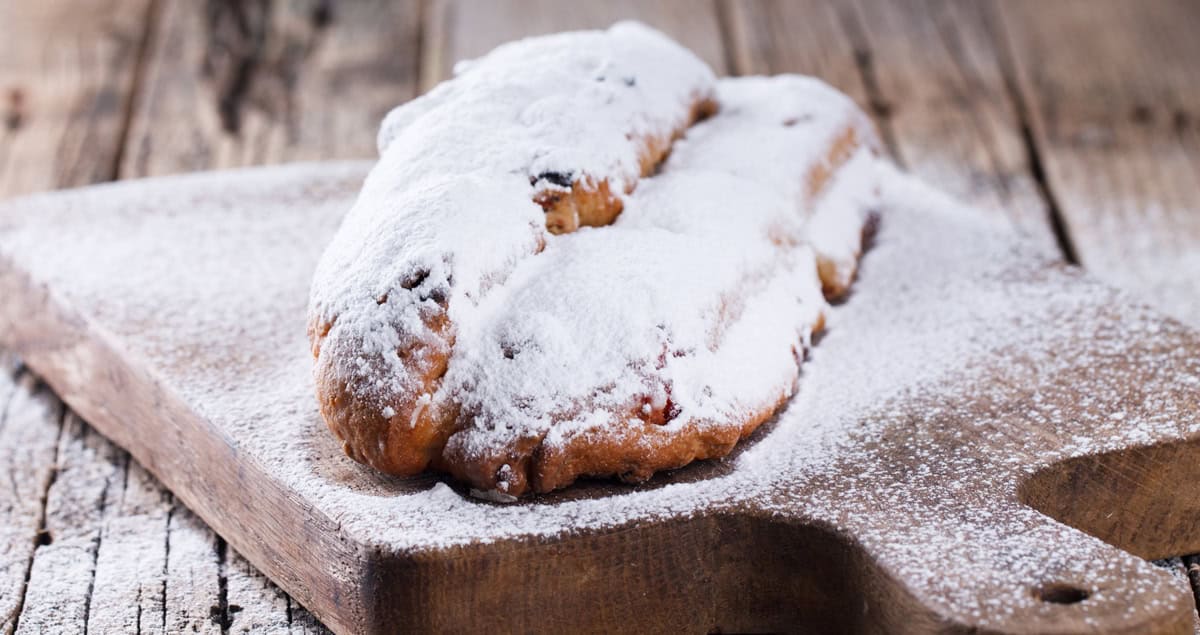
Stollen Variations
Other popular variations of Stollen include Mandelstollen (almond stollen), Mohnstollen (poppy seed stollen), Quarkstollen (made with quark), Nuss-Stollen (nut stollen), Butterstollen (high butter content), Dresdner Stollen and Marzipanstollen (marzipan stollen). Mohnstollen is another one of my favorites.
How to Make the BEST Stollen
For anyone who may be feeling a little intimidated at the thought of making Stollen, don’t be. If you can make a cake or a loaf of bread, you can make Stollen. But while it’s easy to make, it’s not quick to make. There’s a waiting game involved both during the baking process and the aging process. In the baking process the Stollen dough has to rise a couple of times just like in making yeast bread. Then it has to bake for a while. And then there’s the waiting process.
I’m sharing with you my recipe for Stollen which is thoroughly authentic in its method and ingredients. It features dried fruits, candied lemon peel, nuts and marzipan (which you can omit if you choose). I LOVE the addition of marzipan and it’s one of the most popular varieties of Stollen. Don’t worry about having to go out and buy marzipan, it is unbelievably quick and easy to make your own (seriously, it takes about 5 minutes). Check out my recipe for easy homemade Marzipan!
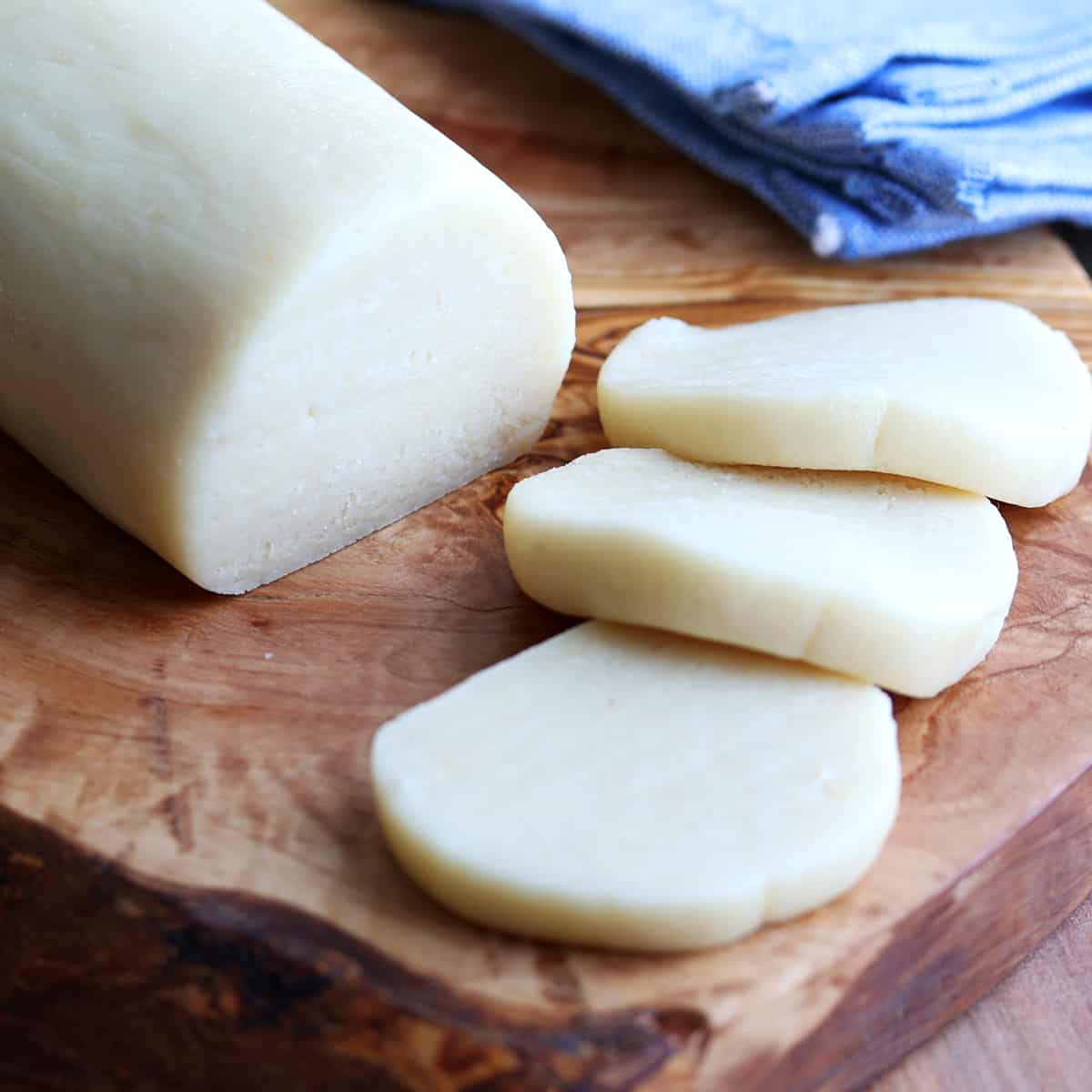
Candied Citrus Peel. Do you hate store-bought candied orange and lemon peel as much as I do? I have to tell you, I absolutely detest store-bought candied citrus peel. And most people I speak to feel the same. It has a bizarre chemical flavor no matter the brand. For that reason I’ve never been a fan of fruitcakes in general. BUT (and there’s a big but) using your own homemade candied citrus peel is a 100% deal changer.
While you can use store-bought candied citrus peel if you insist, I VERY, VERY STRONGLY recommend making your own. Please, trust me on this: Using homemade candied citrus peel is the difference between night and day when it comes to flavor! It is vastly superior in every way and will make your Stollen taste incredible! And the good news is it can be made far, far in advance. In fact, I freeze mine so it lasts basically forever and I take out what I need as needed. Check out my recipe for Candied Orange Peel!

Storage Tips
Typically the Stollen is tightly wrapped and kept in a cool place to age for 2-3 weeks before eating. This allows the liquid from the rum-soaked dried fruits to soak into the bread creating both flavor and moistness.
Fun trivia: Fruitcakes that contain a lot of alcohol can remain edible for years. Yes, years. For example, the Antarctic Heritage Trust discovered a 106-year-old fruitcake last year and after sampling it (the brave souls) they said it was not only in “excellent condition” for its age but was even “almost” edible! Another fruitcake baked in 1878 in Michigan was kept as a family heirloom and sampled for the first time in 2003 by Jay Leno on The Tonight Show. It’s amazing what an incredible preservative alcohol is. So in other words, as long as you keep your Stollen tightly wrapped and in a cool place, letting it age for 2 weeks is, like, nothing.
Does Stollen have to be aged? No! While letting Stollen age will allow the flavors to fully penetrate the bread, this Stollen is absolutely AMAZING straight out of the oven! So the question of whether to wait or not to wait I’ll leave up to you.
If you’ve never been a huge fan of store-bought Stollen you’re not alone. I’ve never cared for them either. But homemade…that’s an entirely different story. Just check out the hundreds of rave reviews below: Your search for the BEST Stollen recipe has ENDED.

Authentic German Stollen Recipe
Let’s get started!
Place the raisins, candied citrus peel and almonds in a medium bowl and pour the rum over it. Stir to combine. Set aside and let the fruit mixture soak in the rum while the dough rises.
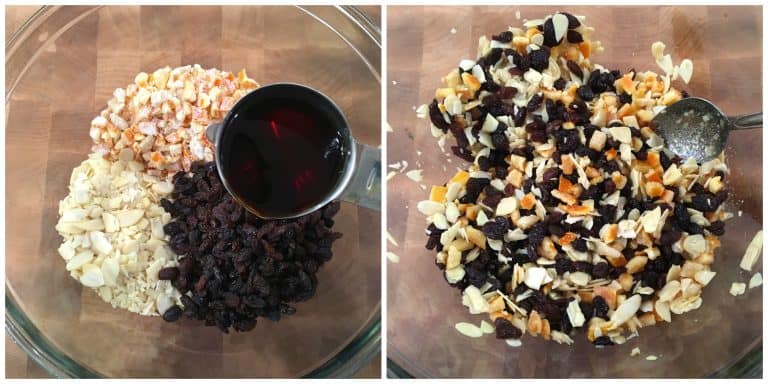
Stir the yeast and 2 tablespoons of the sugar into the lukewarm milk and let sit in a warm place for 10-15 minutes until very frothy.
Place the flour, remaining sugar, egg, egg yolks, butter, vanilla extract, lemon zest, salt, cardamom, mace and cinnamon in the bowl of a stand mixer fitted with a dough hook. Add the yeast/milk mixture.
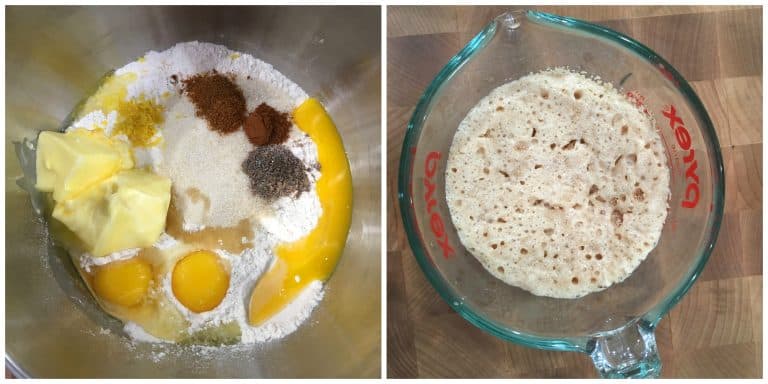
Use a spoon to stir the mixture until it comes together. Knead the dough on the bread setting and once the dough comes together continue to knead for 7 minutes.
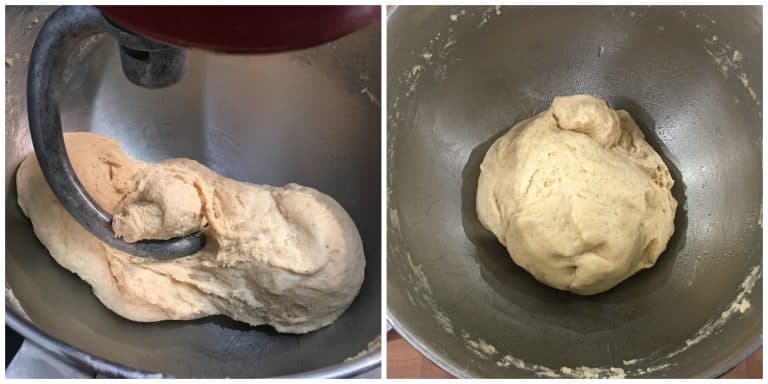
Remove the dough ball, lightly spray the bowl with a little oil, return the dough ball, cover loosely with plastic wrap and place it in a warm place or lightly warmed oven (just barely warm), to rise until nearly doubled in size, at least 1 hour.
Punch down the dough and add the soaked fruit/nut mixture to the dough (it should have absorbed all the rum by now but if there is excess liquid, pour it out before adding the mixture to the dough).
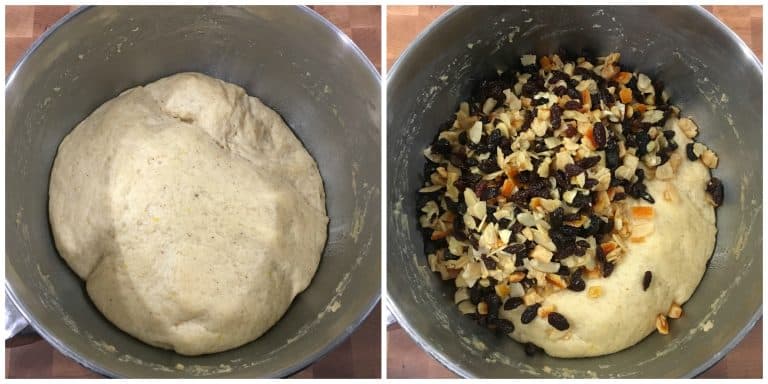
Using the dough hook, knead the fruit/nut mixture into the dough until combined. If the dough is too wet to handle, add a little bit of flour until the dough pulls away from the sides of the bowl. Note: I use my Kitchenaid stand mixer because it’s such a workhorse. You’ll also need a dough hook attachment. There are other pricier options on the market but I’ve been very happy with my Kitchenaid.
Turn the dough out onto a floured work surface.
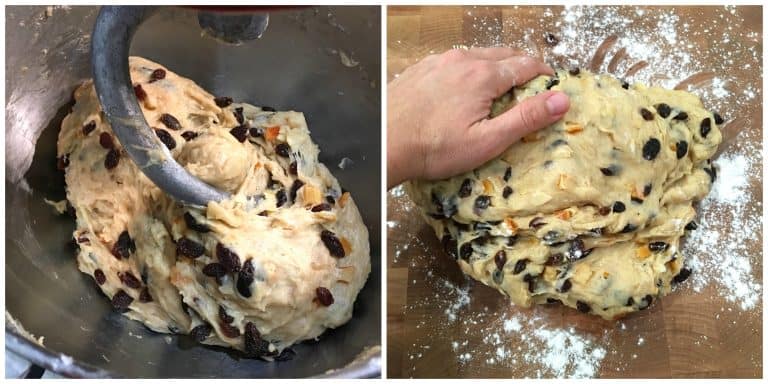
Cut the dough in two equal halves. Press or roll each piece into an oval to about 1 inch thickness. Roll each piece of marzipan into a log the length of the oval. Press the marzipan gently into the middle of the dough.
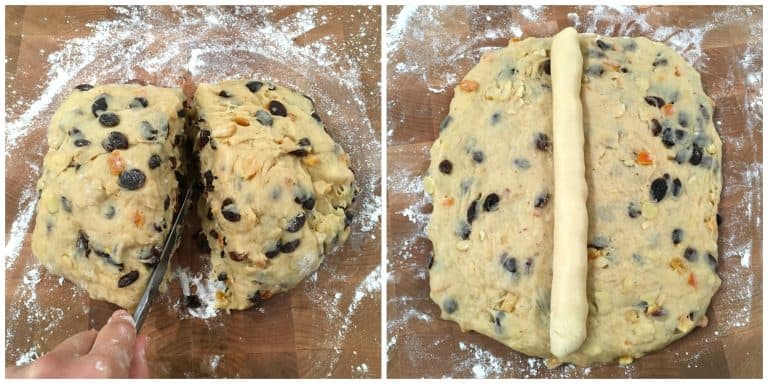
Fold the left side of the dough over to cover the marzipan, then fold right side over on top of the left side so that the edge of it sits just left of the middle of the stollen. In other words, don’t fold the right side all the way over to the left edge of the stollen.
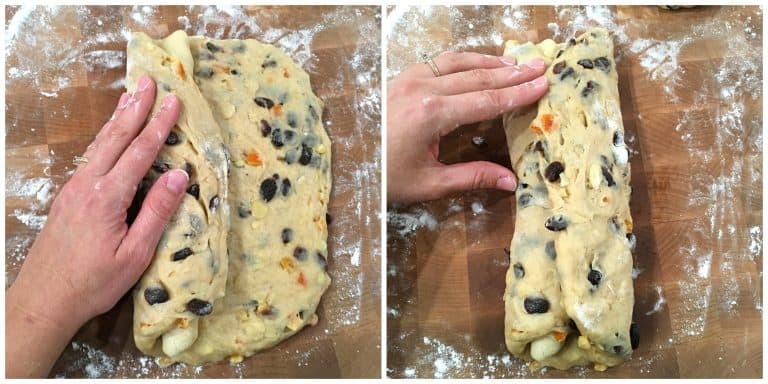
Pinch and tuck the top and bottom ends of the stollen to cover the marzipan.
Use the bottom edge of your hand to press down along the length of the stollen towards the right of the center to create a divot and characteristic hump.

Place the stollen on a lined baking sheet. Cover the stollen loosely with plastic wrap and let them rest in a warm place or lightly warmed oven for 40-60 minutes until puffy.
At this point you can pick off any raisins that are sticking out of the dough (they will burn during baking).

Towards the end of the last rise, preheat the oven to 350 degrees F and bake the stollen for 30-40 minutes or until golden. You can use an instant read thermometer (I love )to aim for an internal temperature of 190 degrees F.
Let them sit for 5 minutes, then use a toothpick to poke holes all over the stollen. This will allow the melted butter to seep in.
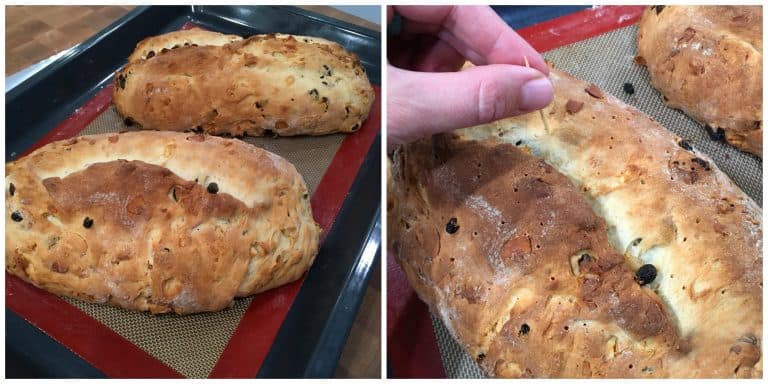
Generously brush the stollen with the melted butter while the stollen are still warm.
Immediately sprinkle with a generous amount of powdered sugar, rubbing it into the creases and down the sides. Let the stollen cool completely.
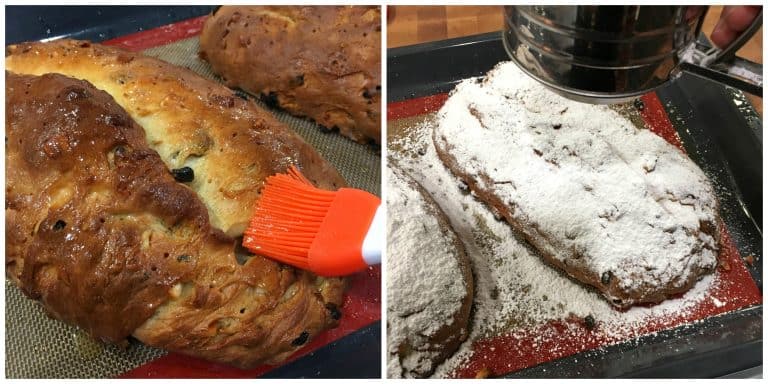
The stollen can be sliced and eaten now or wrapped tightly (I like to wrap in plastic wrap then foil) and left to “ripen” in a cool place for 2 weeks. The liquid from the dried fruits will further penetrate the dough for more flavor and moisture.
Stollen can also be frozen for longer storage.
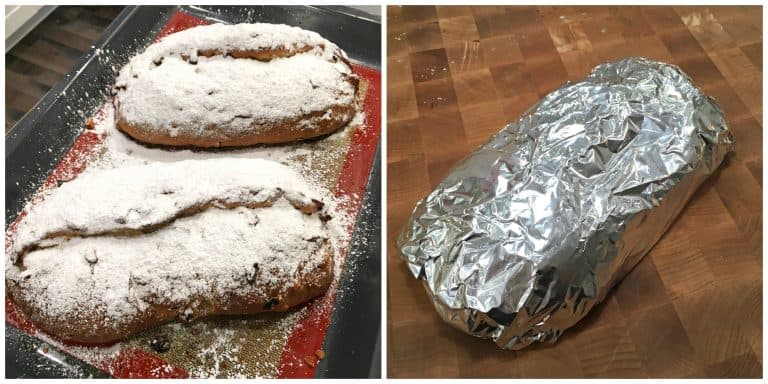
For eating, I like to warm the slices up for a few seconds in the microwave, it makes the crumb nice and soft.
Enjoy!
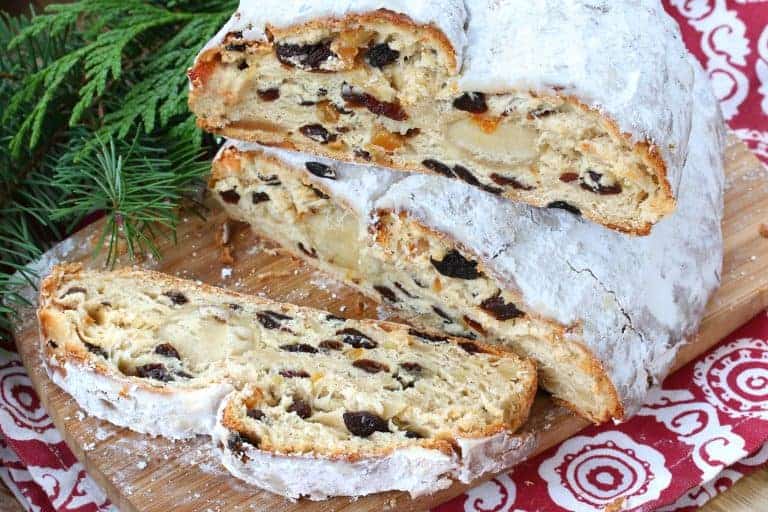
How to Make Gluten Free Stollen
I’m often asked “can I make this gluten free?” Yes, you can make gluten free stollen and I’ve had a several readers report back with success following the same method and simply substituting the flour 1:1 with GF flour. Follow all the same steps, including the rising time, though gluten free dough won’t rise to the same extent. It also won’t have the elasticity that regular dough has so be prepared to use a bench scraper as needed to help shape the dough. Be careful to drain the soaked fruits to eliminate as much excess liquid as possible and be prepared to add a little extra flour as needed until the dough is a workable consistency.
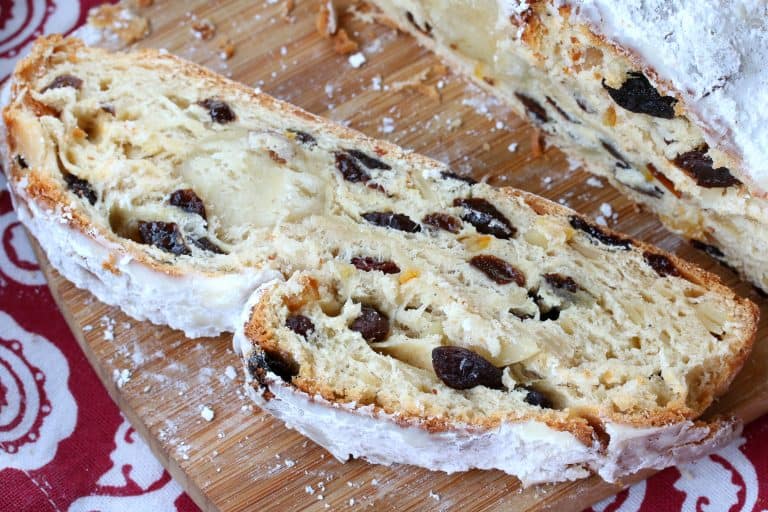
For more traditional German Christmas goodies try my:
- Pfeffernüsse
- Lebkuchen
- Springerle
- Gugelhupf
- Printen
- Speculoos
- Vanillekipferl
- Zimtsterne
- Kokosmakronen
- Magenbrot
- Bethmännchen
- Heidesand
- German Rum Balls
Save This Recipe

Authentic Stollen (German Christmas Bread)
Ingredients
- For the Dough:
- 1 cup lukewarm whole milk
- 3 teaspoons active dry yeast
- 1/2 cup granulated sugar
- 4 to 4 1/2 cups all-purpose flour plus more as needed NOTE: Amount will vary depending on how much liquid is retained in the soaked dried fruit. Be sure to drain any excess liquid. Add more flour as needed if dough is too wet. (Gluten free, substitute 1:1 GF flour.)
- 1 large egg
- 2 large egg yolks
- 3/4 cup unsalted butter (1 1/2 sticks) , at room temperature so it’s very soft
- 2 teaspoons quality pure vanilla extract
- zest of one lemon
- 1 teaspoon salt
- 3/4 teaspoon ground cardamom
- 3/4 teaspoon ground mace (recommended but can substitute nutmeg)
- 1/2 teaspoon ground cinnamon
- 8 ounces Homemade Marzipan/Almond Paste , divided in half (you can omit the marzipan if you prefer)
- or store-bought marzipan/almond paste
- For the Fruits & Nuts:
- 9 ounces raisins
- 3 ounces candied lemon peel , finely diced
- 3 ounces candied orange peel , finely diced
- Homemade Candied Citrus Peel Recipe (we VERY STRONGLY recommend using homemade, it makes ALL the difference!)
- 3 ounces blanched slivered or sliced almonds , finely chopped
- 1/3 cup quality dark rum
- For the Glaze & Dusting:
- 1 stick unsalted butter , melted
- powdered sugar for generous dusting
Instructions
- Place the raisins, candied citrus peel and almonds in a medium bowl and pour the rum over it. Stir to combine. Set aside and let the fruit mixture soak in the rum while the dough rises.
- Stir the yeast and 2 tablespoons of the sugar into the lukewarm milk and let sit in a warm place for 10-15 minutes until very frothy.
- Place the flour, remaining sugar, egg, egg yolks, butter, vanilla extract, lemon zest, salt, cardamom, mace and cinnamon in the bowl of a stand mixer fitted with a dough hook. Add the yeast/milk mixture. Use a spoon to stir the mixture until it comes together. Knead the dough on the bread setting for 7-8 minutes. Remove the dough ball, lightly spray the bowl with a little oil, return the dough ball, cover loosely with plastic wrap and place it in a warm place or lightly warmed oven (just barely warm), to rise until nearly doubled in size, at least 1 hour (likely closer to 2 hours depending on the temperature of the environment).
- Punch down the dough and add the soaked fruit/nut mixture to the dough (it should have absorbed all the rum by now but if there is excess liquid, pour it out before adding the mixture to the dough). Using the dough hook, knead the fruit/nut mixture into the dough until combined. If the dough is too wet to handle, add a little bit of flour until the dough pulls away from the sides of the bowl.
- Turn the dough out onto a floured work surface and cut it in two equal halves. Press or roll each piece into an oval to about 1 inch thickness. Roll each piece of marzipan into a log the length of the oval. Press the marzipan gently into the middle of the dough. Fold the left side of the dough over to cover the marzipan, then fold right side over on top of the left side so that the edge of it sits just left of the middle of the stollen (see pics). In other words, don’t fold the right side all the way over to the left edge of the stollen. Pinch and tuck the top and bottom ends of the stollen to cover the marzipan. Use the bottom edge of your hand to press down along the length of the stollen towards the right of the center to create a divot and characteristic hump (see pics). Place the stollen on a lined baking sheet. Cover the stollen loosely with plastic wrap and let them rest in a warm place or lightly warmed oven for 40-60 minutes until puffy. At that point you can pick off any raisins that are sticking out of the dough (they will burn during baking).
- Towards the end of the last rise, preheat the oven to 350 degrees F and bake the stollen for 30-40 minutes or until golden. You can use an instant read thermometer to aim for an internal temperature of 190 degrees F. Let the Stollen sit for 5 minutes, then use a toothpick to poke holes all over the stollen (this will allow the butter to seep in), then generously brush the stollen with the melted butter while the stollen are still warm. Immediately sprinkle with a generous amount of powdered sugar, rubbing it into the creases and down the sides. Let the stollen cool completely. You may want to give it another dusting of powdered sugar once cooled.
- The stollen can be sliced and eaten now or wrapped tightly (wrap in plastic wrap then foil) and left to "ripen" in a cool place for 2 weeks. The liquid from the dried fruits will further penetrate the dough for more flavor and moisture. Stollen can also be frozen for longer storage.
- Makes 2 large or 3 medium Stollen.For eating, I like to warm the slices up for a few seconds in the microwave, it makes the crumb nice and soft.
Nutrition
Originally published on The Daring Gourmet November 20, 2018



















Hi Kim,
I’ve prepped my ingredients and I’m about to make this tonight! Can I do a slow 2nd rise in the fridge overnight and bake in the morning, or will there be issues from the moisture in the fruit if I do that?
Hi Lauren, without having tried it myself I’m hesitant to make a guess – I’m not sure if/how the moisture collecting in the dough will impact it. If you decide to go that route, please let us know how it goes!
I accidentally (read: pregnancy brain) used the egg whites instead of the yolks, so I’m hoping my first stollen turn out okay. The dough is just lovely to work with and I’m planning out how to adapt it to personal-sized mini stollen of some sort, because I think those would be adorable!
Thank you for a wonderful recipe. I live at 6,000 feet a.s.l and these are the adjustments I had to make, which fortunately worked like a charm. I reduced the yeast to 2 tsp; I added one more yolk; I replaced the butter with oil and used 1/2 cup. I followed your advice and did make my own candied citrus peel -it’s so good- and I made the marzipan. The result was 2 beautiful loaves that are not overly dry. Because I used oil I did have to add quite a bit more flour when I was kneading it -that was scary- but still came out delicious. Your instructions are delightfully clear; thanks for that too.
I’ve made 4 batches and they came out great, for the first try. Haven’t tasted them yet, it’s a German tradition to eat Stollen Christmas morning! Only thing, I needed to add more flour, the dough was sticky and, I used orange liqueur instead of rum, and less citrus, since my children don’t like it too much! Thank you for your recipe!!
You have quite the self-discipline, Freda! Thanks for the feedback and I hope you enjoy your Christmas morning treat!
Hi Kimberly – would the stollen turn out well if using bread flour? I am hoping going for a more higher rise/fluffy/bread-like texture and wondering if this will do the trick. Thanks so much! Really excited to make this for our Christmas table!
Hi Irene, bread flour is higher in protein so it will result in a “chewier”, less tender crumb. If that’s what you’re after then yes, you can substitute it. I would recommend making half the batch first just to be sure you’re happy with the results using bread flour.
Kimberly, I used active dry yeast, the one you can buy in small jars or envelopes. Anyway, the finished stollen tastes good. Maybe when I try the next batch I will have better luck!
Thanks for sharing your yummy recipes.
Okay, then just make sure it says “active dry yeast”, not “instant yeast” (those are really easy to confuse) and let it get really frothy before you add it to the flour. Thanks again!
Hi Kimberly, I made your stollen recipe today with the homemade orange and lemon peel – no marzipan -.
Mine didn’t turn out as pretty looking as yours, but smelled wonderful while baking and tasted good once we cut into them. The loaves came out a little flatter – they spread out more. Yeast doughs never were my forte! I liked that the stollen did not turn out overly sweet.
I love your great recipes and, btw, I too grew up in Stuttgart – many years before you though.
In resonse to Dottie, I was wondering if a simple Hefekranz with raisins could substitute for a stollen. I like it as much as a stollen.
Wonderful, Monika, thanks so much for the feedback! I’m not sure if you used dry or fresh yeast but fresh yeast has to be used in a much smaller quantity, otherwise it causes the dough to rise too fast, fill up with air and then pop and deflate in the oven. Just FYI for anyone else who tries substituting fresh yeast for the dry yeast called for in the recipe.
Hi Kimberly, we have a nut allergy and alcohol intolerance in our house. Obviously the taste would be different, but do you think it would be worth a shot to make this without either? My concern is the benefit of the moisture from the rum-soaked fruit. Is it that substantial? Anyone can do without the nuts, but dry stollen? Blech. Thanks so much in advance for your advice!
Hi Dottie, you bet, you can simply soak the fruit in apple juice, that will address the moisture component. The Stollen will lack some of it’s traditional flavor and won’t keep as long without the rum, but I don’t think they’re going to last long anyway ;)